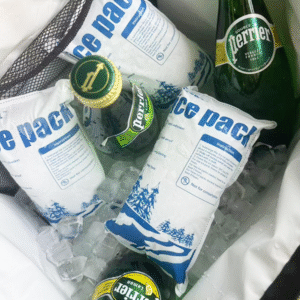Combien pèse chaque pack de glace sec et augmentera-t-il considérablement les coûts d'expédition?
Lors de l'expédition de produits sensibles à la température, La glace sèche est souvent nécessaire pour assurer leur transport sûr. Cependant, Comprendre combien la glace sèche pèse et comment elle affecte les coûts d'expédition est essentielle pour l'optimisation des coûts. Ce guide explique les différentes tailles de pack de glace sèche, Les facteurs qui influencent les frais d'expédition, et des stratégies pratiques pour minimiser les dépenses tout en adhérant aux derniers 2025 Règlements d'expédition.
-
How much does each dry ice pack typically weigh?
-
Comment le poids de la glace sec affecte-t-il les frais d'expédition?
-
Quelles sont les meilleures pratiques pour minimiser les frais d'expédition avec de la glace sèche?
-
Quelles sont les dernières tendances et réglementations pour 2025?
Combien pack chaque pack de glace sec?
Le poids du pack de glace sec varie en fonction de la taille de l'expédition, Type de glace sèche utilisée, et la longueur de l'expédition. En moyenne, La glace sèche utilisée dans les expéditions pèse entre 5 à 50 livres. Smaller shipments may require only 5 livres, while larger shipments can demand up to 50 livres or more depending on factors such as the nature of the goods and transit duration.
Dry Ice Pack Sizes and Weights
Dry ice is typically available in three forms: blocs, boulettes, et pucks. Each form has different weight characteristics and cooling durations:
| Type of Dry Ice | Weight Range | Common Use | Durée de refroidissement |
|---|---|---|---|
| Dry Ice Blocks | 5-25 livres | Long-duration shipments | Jusqu'à 72 heures |
| Granulés de glace sèche | 1-10 livres | Shorter shipments | 12-48 heures |
| Dry Ice Pucks | 5-10 livres | Petites expéditions | 12-24 heures |
Conseil: Pour les expéditions longues, dry ice blocks are preferred, while pellets and pucks are more suited for smaller or shorter duration shipments.
Does Dry Ice Weight Impact Shipping Costs?
The weight of dry ice is a key factor in determining shipping costs. Carriers generally charge based on both the weight and the volume (dimensional weight) of the package. Here’s how dry ice impacts shipping costs:
Weight-Based Shipping Costs:
The heavier the dry ice, the higher the shipping cost. Heavier packages naturally incur higher charges, especially when the package exceeds weight thresholds.
Dimensional Weight Pricing:
In addition to actual weight, carriers may charge based on the volume of the package. Bulky packages containing dry ice may incur higher fees, even if they aren’t especially heavy.
Hazardous Materials Handling Fees:
Since dry ice is classified as a hazardous material, shipping carriers may apply additional handling fees, especially for international shipments that require special labeling, conditionnement, and documentation.
How Does Dry Ice Weight Affect Domestic vs. Expédition internationale?
The weight of dry ice can have a different impact on domestic and international shipments:
Domestic Shipping:
For domestic shipments, costs are generally determined by the weight and size of the package. Major carriers like Hauts et FedEx have specific rates for shipments containing dry ice. Shipping costs can be influenced by the weight, taille, and the type of service (du jour au lendemain, sol, etc.).
Expédition internationale:
Pour les expéditions internationales, dry ice is classified as a bien dangereux, which results in additional handling fees, special labeling, et paperasse. En outre, many international regulations limit the maximum weight of dry ice that can be shipped in one package, leading to higher overall costs.
Comparison of Costs for Different Shipping Types:
| Shipping Type | Cost Impact | Additional Charges |
|---|---|---|
| Domestic | Poids + Taille | Possible fuel surcharges |
| International | Poids + Taille + Dangerous Goods Fees | Special handling, documentation, étiquetage |
Can You Reduce Shipping Costs With Dry Ice?
Although dry ice can increase shipping costs, there are several strategies you can use to minimize these expenses:
Optimized Packaging:
Using high-quality insulated packaging, tel que vacuum-insulated panels (VIP), can significantly reduce the amount of dry ice required. Better insulation keeps the temperature stable for longer, reducing the need for excessive dry ice.
Efficient Sizing:
Ensure that you use the exact amount of dry ice needed. Overestimating can lead to unnecessary costs, while underestimating can risk product spoilage. Proper calculation based on the temps de transit et product weight est crucial.
Consolidate Shipments:
Si possible, combine multiple smaller shipments into one larger package. This approach allows you to spread out the cost of dry ice and the shipping fee across several items, ultimately reducing per-item shipping costs.
Exemple pratique:
Une entreprise expédiée aliments sensibles à la température can minimize costs by using an insulated shipping container and choosing the correct amount of dry ice. This strategy ensures that the products remain safe without excess dry ice leading to higher shipping costs.
2025 Latest Trends in Dry Ice Shipping and Costs
Emballage respectueux de l'environnement:
The growing demand for sustainability in the logistics industry has led to innovations in eco-friendly packaging materials. Panneaux isolés sous vide (VIP) Offrir une isolation supérieure, reducing the need for large amounts of dry ice. These packaging materials not only lower costs but also help companies meet environmental goals.
Regulatory Changes and Compliance:
À ce jour 2025, stricter regulations are being enforced on dry ice shipping, particularly for international shipments. Companies must adhere to new Iata et USPS règlements, which include better labeling and documentation requirements.
Alternative Cooling Solutions:
Matériaux à changement de phase (PCMS) are being introduced as a more sustainable alternative to dry ice. These materials provide cooling at specific temperatures and can reduce reliance on dry ice for certain types of shipments.
Perspicacité du marché:
The demand for dry ice shipping continues to grow with industries like médicaments et services de livraison de nourriture. Innovations dans conditionnement et sustainable practices are crucial to reducing the environmental impact of dry ice shipping.
Questions fréquemment posées (FAQ)
Q1: How do shipping companies charge for dry ice?
Shipping companies charge for dry ice based on its weight and size. En plus, they may apply hazardous materials handling fees, particularly for international shipments.
Q2: Is dry ice considered a hazardous material?
Oui, dry ice is classified as a matières dangereuses due to its potential to displace oxygen and cause asphyxiation in confined spaces. Special packaging and handling are required for shipments containing dry ice.
Q3: How can I reduce the cost of dry ice shipping?
Optimisez votre emballage, use the right amount of dry ice, and consolidate shipments to reduce the overall cost. Efficient insulation and accurate calculations are key to minimizing unnecessary expenses.
Conclusion & Recommandations
Understanding the weight of dry ice and its impact on shipping costs is crucial for businesses that rely on temperature-sensitive products. By optimizing packaging, accurately calculating dry ice needs, and staying updated on 2025 règlements, you can ensure that your shipments are both safe and cost-effective.
Recommended Actions:
-
For Cost Efficiency: Use insulated packaging to reduce the amount of dry ice required.
-
For Domestic Shipments: Avoid overestimating dry ice needs and choose packaging that minimizes size.
-
For International Shipments: Be aware of hazardous material fees and comply with international regulations.
À propos du tempk
Tempk provides innovative solutions in logistique de la chaîne du froid, spécialisé dans emballage à température contrôlée and efficient shipping methods. We use advanced insulated materials to ensure your shipments remain safe and cost-effective while adhering to the latest regulatory standards.
Contacter le tempk today to discuss how we can help optimize your dry ice shipping needs.
























